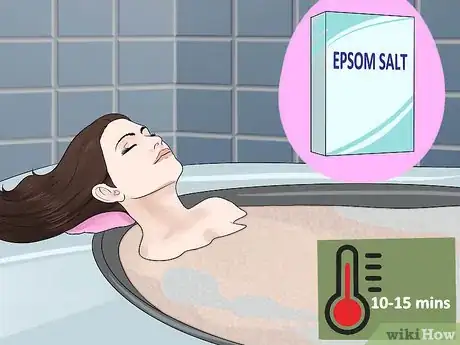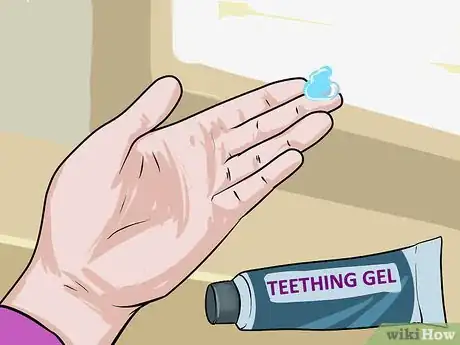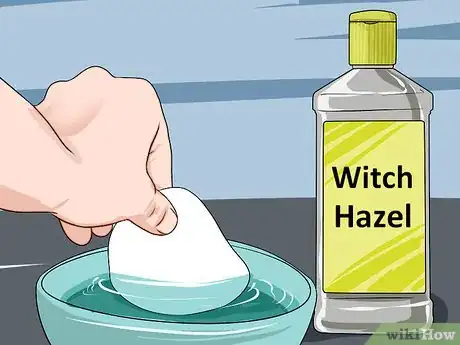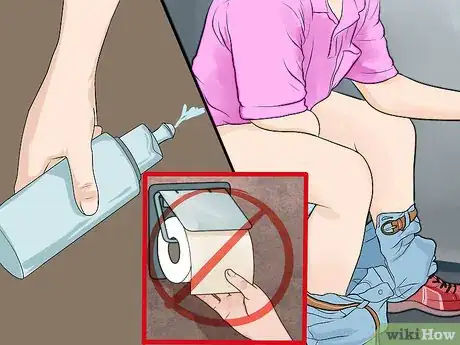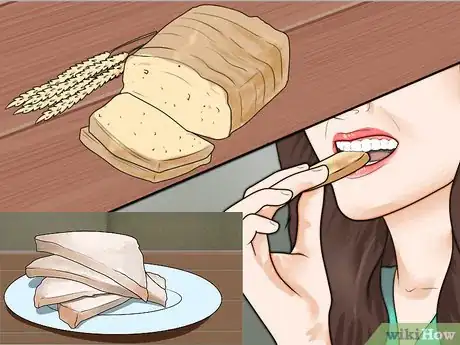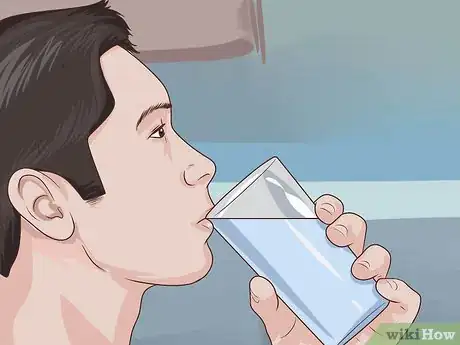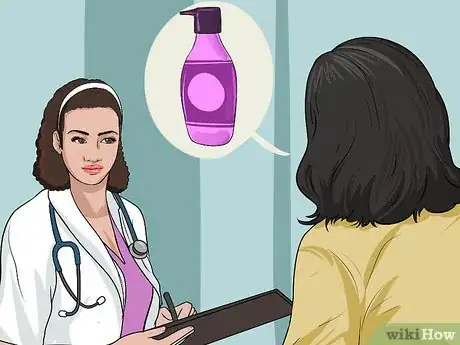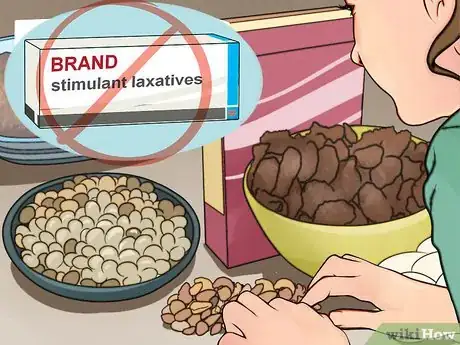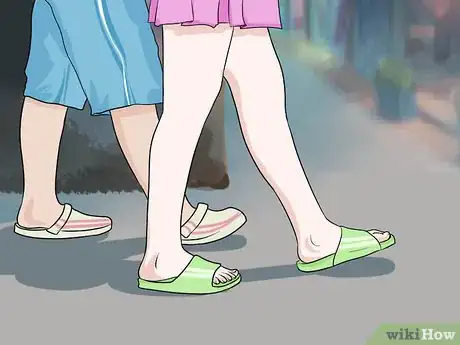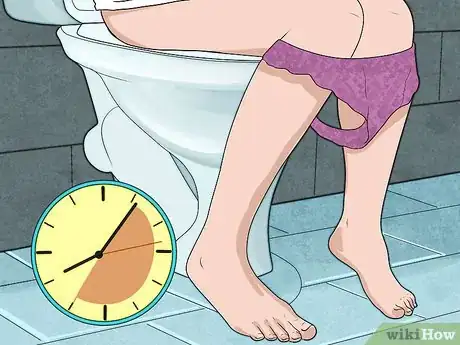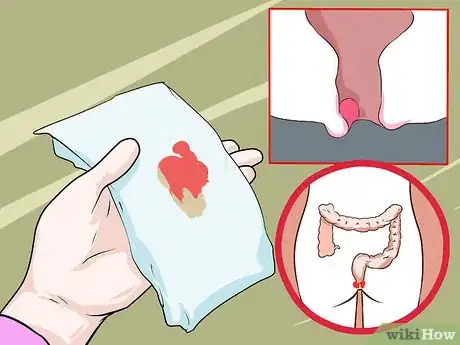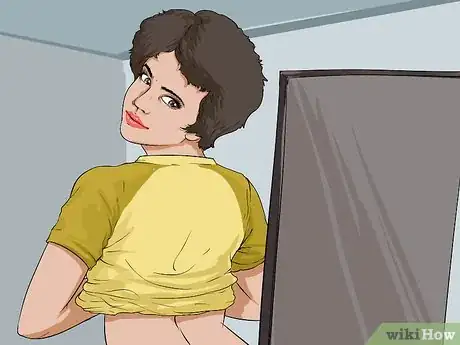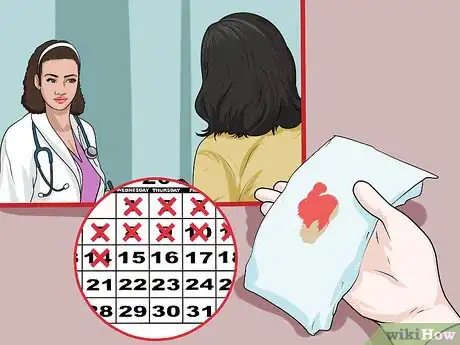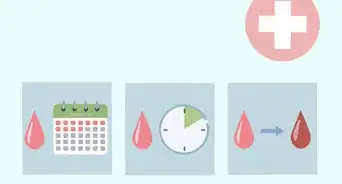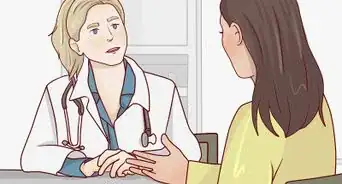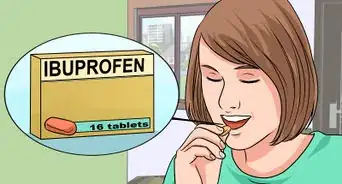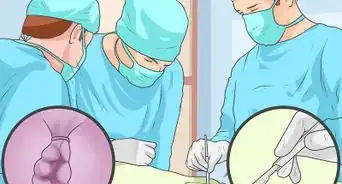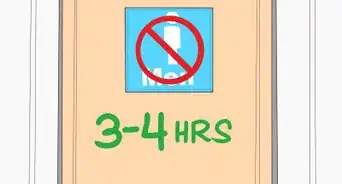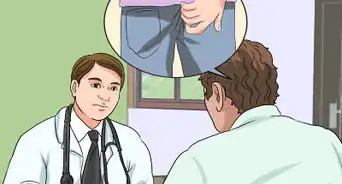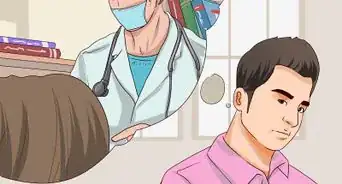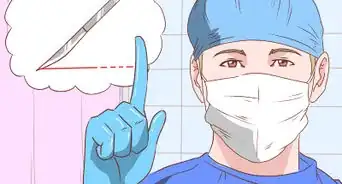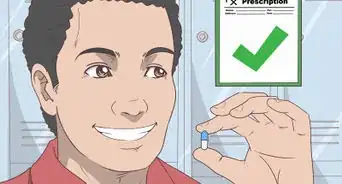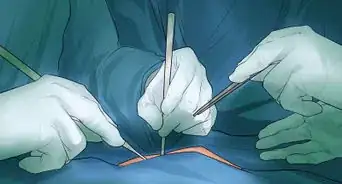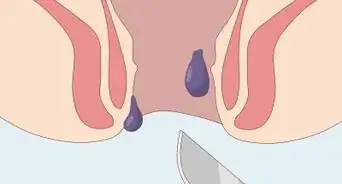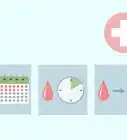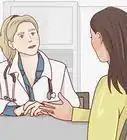This article was co-authored by Luba Lee, FNP-BC, MS and by wikiHow staff writer, Jessica Gibson. Luba Lee, FNP-BC is a Board-Certified Family Nurse Practitioner (FNP) and educator in Tennessee with over a decade of clinical experience. Luba has certifications in Pediatric Advanced Life Support (PALS), Emergency Medicine, Advanced Cardiac Life Support (ACLS), Team Building, and Critical Care Nursing. She received her Master of Science in Nursing (MSN) from the University of Tennessee in 2006.
There are 13 references cited in this article, which can be found at the bottom of the page.
This article has been viewed 74,742 times.
You may be prepared to get hemorrhoids during pregnancy, but are surprised when they show up after the baby's born. Hemorrhoids, enlarged veins around the anus, are caused by increased pressure and strain. You may get hemorrhoids after pregnancy because of the pressure from pushing during labor. Fortunately, there are lots of things you can do to manage the pain of hemorrhoids until they clear up.
Steps
Relieving Hemorrhoid Pain
-
1Take warm baths. If you run a full warm bath, add 1 cup of Epsom salts. If you run only a few inches of water in a bathtub, add 2 to 3 tablespoons. Make sure the water is not too hot or it could make your hemorrhoid more painful. Soak in the bath for 10 to 15 minutes a few times a day.[1]
- You can also use a sitz bath, a small tub that you place over the toilet so you can soak only your bottom. You can use a sitz bath multiple times a day to speed up healing.[2]
- This might be a good chance for you to relax while someone else takes care of the new baby. Or, use the time to nurse the baby.
-
2Apply a warm or cold compress. Get a clean, cotton washcloth and soak it in warm (not hot) water. If you want, you can put a few tablespoons of Epsom salts in the water before soaking the cloth. Apply the compress directly to your hemorrhoid for about 10 to 15 minutes 3 times a day.
- You can also try using ice packs to reduce the swelling but only use them for 5 to 10 minutes and make sure not to apply the pack directly to your skin. This can cause tissue damage.[3]
- Try alternating a warm compress with cold packs.
- To use an ice pack, wrap it in a cloth before holding it against your hemorrhoid. Keep the ice pack there for up to 15–20 minutes. Avoid using an unwrapped ice pack or holding one there for any longer so you don’t damage your skin.[4]
Advertisement -
3Use pain and itch-relieving gels or lotions. Apply aloe vera gel or an ointment that has phenylephrine. Phenylephrine acts as a decongestant, which can help shrink the hemorrhoid. Aloe vera gel has been shown to prevent infection and help heal minor wounds.[5] You can also purchase hemorrhoid cream from the drugstore.
- Apply steroid creams, such as 1% hydrocortisone, in moderation since these can damage the delicate tissue around a hemorrhoid.[6]
-
4Shrink the hemorrhoids with an astringent. Take a cotton pad and soak it in witch hazel, or buy pre-soaked pads from your local pharmacy. Apply the pad to the hemorrhoid for several minutes. Repeat this as often as you like, especially after painful bowel movements, or at least 4 or 5 times a day.
- Witch hazel acts as an astringent and can reduce swelling.
-
5Be gentle when cleaning yourself. Avoid using toilet paper to clean yourself after toileting.[7] Instead, fill a plastic peri-bottle with warm water and squirt the area. Gently pat the area dry with a soft cloth. Avoid using baby wipes, which can further irritate the area.
- You might have gotten a peri-bottle from the hospital or you can buy them at a drugstore or pharmacy.
-
6Use a donut pillow if you need to sit for a prolonged time. Try to avoid sitting for a long time as much as you can when you have hemorrhoids. If you have to sit down, put a donut pillow on the seat first. This will help relieve pressure from sitting on the hemorrhoid so it doesn’t get as irritated.[8]
Preventing Hemorrhoids
-
1Increase the fiber in your diet. It's important to prevent straining and pressure when you have hemorrhoids. Fiber helps keep water in the stool and bulks it up so that it's easier to pass (and with less pain). Try to eat 21 to 25 grams of fiber a day. Good sources include:[9]
- Whole grains: brown rice, barley, corn, rye, bulgur wheat, kasha (buckwheat), and oatmeal
- Fruits (especially with the rinds or peels): apples, raspberries, pears
- Vegetables: leafy vegetables like Swiss chard, collard and mustard greens, spinach, lettuces, beet greens
- Beans and legumes (which may cause intestinal gas)
- Fiber supplements, such as psyllium
-
2Drink lots of water. The Institute of Medicine recommends that you drink 8 to 10 eight-ounce glasses of water a day.[10] Not only will this help your body function normally, but hydration can help your hemorrhoids. Specifically, water can also help soften your stools making them easier to pass.
- You can also drink juices or clear broths if you get tired of drinking water.
-
3Consider using laxatives. There are several types of laxatives that make toileting with hemorrhoids easier. Bulk laxatives often contain fiber to increase the mass or weight of the stool. Or, you could use stool softeners which also make stools soft and easy to pass. Lubricant laxatives can lubricate the walls of the intestines and rectum which makes the stool pass easier. Regardless of what you choose, use laxatives only once or twice per week.[11]
- If you're nursing, talk with a doctor before taking laxatives. Some ingredients may pass to the baby and cause diarrhea.[12]
- You can try a natural softener like senna or psyllium. Senna is a gentle stimulant laxative that has been used for centuries to relieve constipation. You can take senna as tablets (follow manufacturer’s instructions) or as a nightly tea. Or you can try psyllium fiber which is a natural bulking agent.
- Milk of magnesia and mineral oil are also natural stool softeners.
-
4Avoid using stimulant laxatives. These stimulate the bowels to pass stools, but these are more likely to be habit-forming than other laxatives. If you use stimulant laxatives, try to only use them once or twice, since they are the harshest and can cause dehydration.[13]
- Instead of using stimulant laxatives, try to increase the fiber in your diet to improve your stools. You can sprinkle psyllium into oatmeal, yogurt, or a smoothie. You may also try herbal tea, like ginger, licorice, or senna, to help with digestion.
-
5Exercise. Keep your body moving to keep your bowels moving. This essentially massages them. You can do any type of exercise: aerobic, endurance, cardiovascular, or just walking. As your body moves, internal organs move and get massaged as well.
- Be in the habit of exercising 20 to 30 minutes a day.[14]
-
6Schedule bathroom breaks. Arrange regular times to use the bathroom without interruptions which can make bowel movements easier. But, if you feel the urge to have a bowel movement, don't wait. Go as soon as you can, but don’t sit for too long waiting. Sitting is associated with an increased risk of hemorrhoids.
- Avoid straining which is one of the main causes of hemorrhoids. Let gravity help, but let your bowels do most of the work. If nothing happens, wait 30 minutes or so and try again.
Recognizing Hemorrhoids
-
1Be prepared for hemorrhoids after pregnancy. Your body just went through a lot of changes during and immediately following pregnancy. These physical, mental, and emotional changes can all cause strain. Your body is recovering from carrying a heavy growing fetus and your digestive system is recovering from the physical changes of pregnancy. These can increase the chance of constipation which aggravates hemorrhoids.
- Hemorrhoids after pregnancy and delivery are commonly caused by pushing during labor.[15]
-
2Recognize external hemorrhoids. You may notice blood on the toilet paper or in the toilet after having a bowel movement. This is the most common symptom. Hemorrhoids can also be itchy and painful. You may feel an external hemorrhoid when cleaning yourself. It will be a tender swelling around the anal opening. You won’t usually feel internal hemorrhoids, but they can bulge through the anal opening.[16]
- If your hemorrhoid is larger than the size of a quarter, seek medical attention as this could signal a more serious condition.
- A physician can diagnose internal or external hemorrhoids by performing a rectal exam. If rectal bleeding is not caused by a hemorrhoid, your doctor will probably recommend a more extensive test called a sigmoidoscopy or a colonoscopy because one of the symptoms of colon cancer is rectal bleeding.[17]
-
3Look for external hemorrhoids. Stand with your back facing a large floor length or bathroom mirror. Bend over slightly while turning your head to face the mirror. Look closely at your anus to see if there are any lumps or if there's a swollen mass. These may be hemorrhoids.
- Alternatively, you can sit with your legs open and use a lighted mirror to look for hemorrhoids.
- The lumps or mass may be the same color as your skin tone or they might appear darker red.
-
4Know when to get medical attention. If you're using home treatments, hemorrhoids will usually resolve within a week or two. If they don't, call your doctor or midwife. Occasionally for external hemorrhoids and more often for internal hemorrhoids, you may still need medical intervention. The most common medical treatments are:[18]
- Ligation: tying a rubber band around the base of the hemorrhoid to cut off blood flow
- Injection of a chemical solution: to shrink the hemorrhoid
- Cauterization: burning the hemorrhoid
- Hemorrhoidectomy: surgical removal of the hemorrhoid
Expert Q&A
-
QuestionThere is a lump around my anus, but it doesn't bleed. Is this considered hemorrhoids?
 Luba Lee, FNP-BC, MSLuba Lee, FNP-BC is a Board-Certified Family Nurse Practitioner (FNP) and educator in Tennessee with over a decade of clinical experience. Luba has certifications in Pediatric Advanced Life Support (PALS), Emergency Medicine, Advanced Cardiac Life Support (ACLS), Team Building, and Critical Care Nursing. She received her Master of Science in Nursing (MSN) from the University of Tennessee in 2006.
Luba Lee, FNP-BC, MSLuba Lee, FNP-BC is a Board-Certified Family Nurse Practitioner (FNP) and educator in Tennessee with over a decade of clinical experience. Luba has certifications in Pediatric Advanced Life Support (PALS), Emergency Medicine, Advanced Cardiac Life Support (ACLS), Team Building, and Critical Care Nursing. She received her Master of Science in Nursing (MSN) from the University of Tennessee in 2006.
Board-Certified Family Nurse Practitioner The lump around your anus can be a hemorrhoid. When a hemorrhoid heals it may leave an excess of skin that feels like a lump. However, it is a good idea to let your health-care provider evaluate your concern to rule out any other health conditions.
The lump around your anus can be a hemorrhoid. When a hemorrhoid heals it may leave an excess of skin that feels like a lump. However, it is a good idea to let your health-care provider evaluate your concern to rule out any other health conditions.
References
- ↑ http://www.mayoclinic.org/diseases-conditions/hemorrhoids/basics/lifestyle-home-remedies/con-20029852
- ↑ https://www.saintlukeskc.org/health-library/taking-sitz-bath
- ↑ http://www.mayoclinic.org/diseases-conditions/hemorrhoids/basics/lifestyle-home-remedies/con-20029852
- ↑ https://fairview.org/sitecore/content/Fairview/Home/Patient-Education/Articles/English/t/r/e/a/t/Treating_Hemorrhoids_SelfCare_82170
- ↑ http://www.health.harvard.edu/diseases-and-conditions/hemorrhoids_and_what_to_do_about_them
- ↑ https://www.mayoclinic.org/diseases-conditions/hemorrhoids/diagnosis-treatment/drc-20360280
- ↑ http://www.health.harvard.edu/diseases-and-conditions/hemorrhoids_and_what_to_do_about_them
- ↑ https://www.whattoexpect.com/baby-products/postpartum/carex-inflatable-donut-pillow-sitting-postpartum/
- ↑ http://www.mayoclinic.org/healthy-lifestyle/nutrition-and-healthy-eating/in-depth/high-fiber-foods/art-20050948
- ↑ http://www.mayoclinic.org/healthy-lifestyle/nutrition-and-healthy-eating/in-depth/water/art-20044256
- ↑ http://www.mayoclinic.org/diseases-conditions/constipation/in-depth/laxatives/art-20045906
- ↑ http://www.mayoclinic.org/diseases-conditions/constipation/in-depth/laxatives/art-20045906?pg=2
- ↑ http://www.ncbi.nlm.nih.gov/pmc/articles/PMC3418980/
- ↑ http://www.health.harvard.edu/diseases-and-conditions/hemorrhoids_and_what_to_do_about_them
- ↑ http://www.whattoexpect.com/pregnancy/symptoms-and-solutions/hemorrhoids.aspx
- ↑ http://www.health.harvard.edu/diseases-and-conditions/hemorrhoids_and_what_to_do_about_them
- ↑ https://my.clevelandclinic.org/health/diseases_conditions/hic-colorectal-cancer
- ↑ http://www.health.harvard.edu/diseases-and-conditions/hemorrhoids_and_what_to_do_about_them
About This Article
To treat a hemorrhoid after pregnancy, add a cup of Epsom salt to a warm bath and soak in it for 10-15 minutes. You can nurse your baby while you’re in the bath or let someone else take care of them. Alternatively, soak a clean washcloth in warm water and hold it to your hemorrhoid for 10-15 minutes 3 times a day. You can also use an ice pack wrapped in a clean towel for 5-10 minutes to reduce the swelling. Try alternating warm and cold compresses or use whatever works best for you. If you have any witch hazel, soak a cotton pad with it and apply it to your hemorrhoid for a few minutes. Repeat this as often as you like to relieve your discomfort throughout the day. For more tips from our Medical co-author, including how to prevent hemorrhoids, read on.
